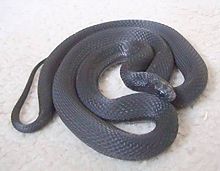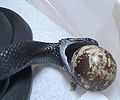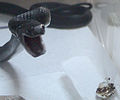|
Dasypeltis
Dasypeltis is a genus of snakes, also known commonly as egg-eating snakes or egg-eaters, in the subfamily Colubrinae of the family Colubridae. The genus is one of only two taxonomic groups of snakes known to have adapted to feed exclusively on eggs (the other being the genus Elachistodon). Dasypeltis are non-venomous and found throughout the continent of Africa, primarily in forested or wooded habitats that are also home to numerous species of birds. Species and subspeciesThere are 18 species of Dasypeltis that are recognized as being valid, one of which has recognized subspecies.[1]
Nota bene: A binomial authority in parentheses indicates that the species was originally described in a genus other than Dasypeltis.  DescriptionThe species of the genus Dasypeltis exhibit a wide variation in patterning and color, from mixtures of browns and greens, to solid black. Individuals in a specific locality tend to share similar color and pattern. They vary in size greatly, from 30–100 cm (12–39.5 in) in total length (including tail).[citation needed] BehaviorDasypeltis species tend to have a nervous disposition, and when threatened will perform what is called saw-scaling, a behavior in which the snake will rub the scales on the sides of its body together quickly to make a rasping noise that sounds like hissing. They are agile climbers, and have a keen sense of smell to tell whether an egg is rotten or too far developed to be comfortable to eat. They have extremely flexible jaws and necks for eating eggs much larger than their head, and have no teeth, but they do have bony protrusions on the ventral side of their spine which are used to aid in breaking the shells of eggs.[citation needed] The process of consuming an egg involves wrapping their mouth around it and drawing it into the throat with their jaws, and then flexing their neck muscles to push the egg into the bony protrusions on their spine, which causes the egg to collapse in on itself. Then the snake carefully squeezes the liquid out of the inside of the egg, swallowing the contents, and ends with regurgitation of the completely crushed egg shell. They are remarkably efficient, and waste very little of the contents of an egg.[citation needed] GalleryA sequence of a montane egg-eating snake, Dasypeltis atra, consuming a quail egg: grasping egg, swallowing egg, breaking egg and ingesting contents, regurgitating shell. In captivityDasypeltis species are readily available in the exotic pet trade, but due to their unique dietary needs they can be a challenge to keep in captivity. Most egg-eating snakes never get large enough to consume typical chicken eggs, so smaller ones must be provided, such as finch or quail eggs. Once a reliable source(s) of food is obtained, Dasypeltis make easy and hardy vivarium species. Captive breeding is virtually unknown, so almost all specimens available are wild caught.[citation needed] Many owners have resorted to force-feeding their Dasypeltis because the animal seems not to be eating. However, evidence has shown that, like large constrictors, these snakes may go for very long periods (months) without eating after a large meal. As long as the snake is behaving normally and does not appear to be in physical distress, force-feeding is not advised. When a specimen seems to be "off" its food, offering it eggs approximately monthly is appropriate. If the snake does not eat but continues to drink, is active, and sheds, then it does not need to be force-fed.[citation needed] References
Further reading
External linksWikimedia Commons has media related to Dasypeltis. Wikispecies has information related to Dasypeltis. |
||||||||||||||||||||||||||||||||
Portal di Ensiklopedia Dunia




